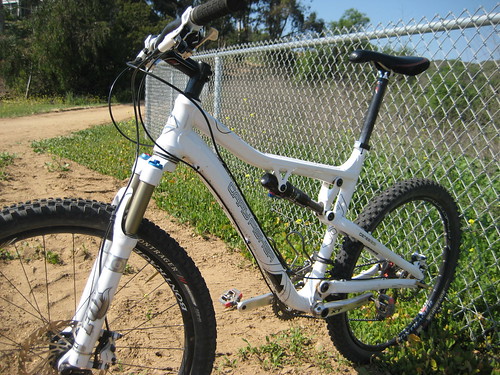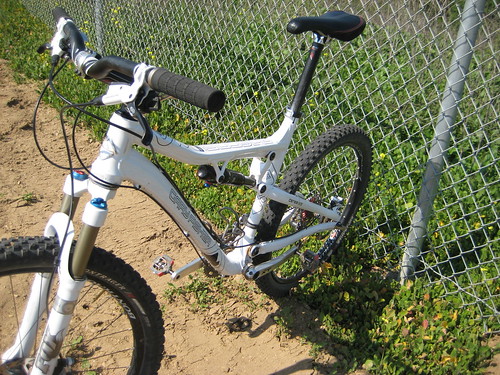Trek Demo Day, Part II

Gary Fisher Roscoe III
Round number 2 was on the Gary Fisher Roscoe. I had to wait a little while for this one as some dude drove from Vegas to test ride it. That’d be 4 plus hours of driving each way!
Before we get going on the review, I have to preface my thoughts on the Gary Fisher Roscoe with this statement: My riding style is not the one that is being targeted by the Roscoe. I am definitely more of a XC/Trail type rider while the Roscoe with its five and a half inches of travel is definitely shooting for the All Mountain crowd. I have ridden AM type bikes but I am just too timid to really get the best out of them, the Roscoe included. Also, the Fullerton Loop is not an AM type trail so I’d definitely read my thoughts with this information in mind.

Wide hydroformed top tube makes for a much stiffer frame
On our second run, we hooked up with John from Jax Fullerton. He jumped on the Superfly I was riding while Full Squish Randall got on HiFi 29er and I got some seat time on the Roscoe. John, by the way, is a great mechanic and happens to be a very good road racer as well.
My first thought when I got on the Roscoe is that this baby is stout. The hydroformed tubing is thick. The first tube you notice is the top tube which is much wider than any other top tube I’ve ridden. This definitely lent a bit of stiffness to the whole bike that I’m sure is useful when you’re hucking off 6 foot drops. You really can’t tell the thickness in the pictures on Gary Fisher’s website but the top & down tube are wide. The tapered headtube is also different going from 1 1/8 inch to 1 1/2 inch at the crown of the fork. This design is supposed to increase the strength between the headtube and fork, but nothing on the loop was gnarly enough to test this.

Proprietary Dual Rate Control Valve (DRCV) shock made things plush
Coming off the hardtail Superfly I also immediately noticed how plush the suspension travel was. It was almost like night and day and rightfully so going from the racey Superfly to the AM Roscoe. The proprietary Dual Rate Control Valve (DRCV) was smooth and felt good on all the extra credit stuff I threw at it. I also got some time on the HiFi 29er later on and the 4 inches of travel on the HiFi doesn’t have nearly the plushness of the Roscoe’s DRCV shock. Not even close.
The Roscoe does not like for the rider to stand up and hammer out climbs. Every time I tried to stand and climb I immediately felt like the Roscoe telling me to sit back down. The bike is definitely more of a spin, spin, spin type climber which I think is fine and lends itself well to this style of mountain biking.

White bikes with white forks always look good to me. The beefy tires were a bit too aired up for excellent grip
The steering was not as slack as I remember other AM rigs I’ve ridden. The last time I rode an AM rig I distinctly remember that the steering was very slow which is great on the descents as it made things a bit more stable. The flipside to this is that it slowed things down too much for me on the switchbacks and tricky sections that require more finesse and less of a plow through mentality. The G2 steering on the Roscoe, however, seemed to give the best of both worlds as it still had some pep through the tight stuff but retained its stability for the downhill.
As you can probably tell I am a little high on the Roscoe. I think this is mainly because 1. the bike is really good and 2. the 10 mile Fullerton Loop is too short to shake out the bike entirely. More time on the bike is definitely needed to draw definitive conclusions.
Rode the Roscoe myself at a recent demo (had come for the Hi-Fi 29er, but it was not available).
Your right not as slack, at least in feel as other AM bikes, but handles wonderfully, and very plush. Took it for a 30 min. climb, and I was in the seat while others were standing up, felt light, climbed better than most.
I had been looking at the Hi-Fi, which I demoed too, but I kept bottoming out and hitting my pedals — which I won’t have probably noticed if I hadn’t tried the Roscoe, which had none of that.
Well I have Hi-Fi 29er demo coming up, so fingers crossed.
On reflection…
I would swap out the Bontrager Rhythm saddle, not all that comfortable during a long ride (reminds me of my old SDG), and I’d swap out the Bontrager XDX tires — these tires are just not appropriate for the roots, rocks, and wet, nor fire roads (standard one tire fits all OEM).